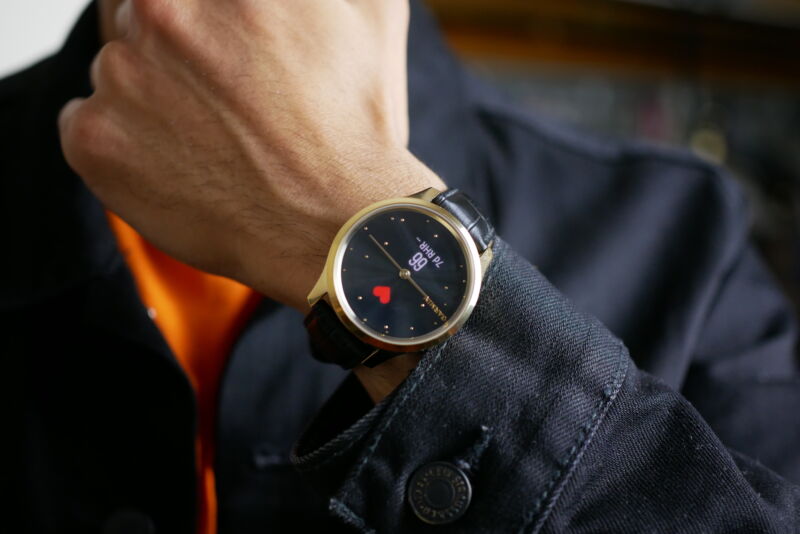
Believe it or not, there are smartwatches worth owning other than the Apple Watch. If getting important (or not so important) notifications on your wrist in 2021 sounds appealing to you, there’s great news: Most smartwatches can do that for you now. And you have options when it comes to style, form factor, and more dedicated wearable purposes.
There are smartwatches that emphasize style and the classic timepiece aesthetic, others that help you train for competition in specific sports, and truly everything in between. From casual exercisers to those who want every bit of data and guidance they can get, the smartwatch landscape has matured. There’s a great fit out there for us all. And recently, we revisited some of our favorite smartwatches and tested the latest releases in an effort to compile the best this landscape has to offer and help you nail down the best one for your needs.
Table of Contents
The short(er) version
- The Apple Watch Series 6 is still the best all-around smartwatch available. No other wearable offers close to the app variety, ecosystem cohesiveness, and third-party support that the Apple Watch does. Battery life is just okay, and tracking could be more extensive, but the Series 6's all-around package is tough to beat. Meanwhile, the Apple Watch SE and Series 3 can save you a few bucks depending on your needs.
- Our runner-up is the Fitbit Sense. It doesn't have the Apple Watch's extensive app support, but it offers nearly the same level of fitness hardware (ECG, blood oxygen sensors, heart rate, GPS), week-long battery life, a more in-depth companion app, and actual Android support, all in a stylish design.
- If you can find it for less than $200, the Fitbit Versa 3 is another option we like. It has a nice combination of sleek smartwatch looks (in both software and hardware) and the requisite fitness tracking and notification capabilities we expect at that price point. There's no ECG sensor, but it should have you covered with basic to moderate health insights otherwise.
- Garmin’s Forerunner 745 is our top runner’s watch for its deep training stats, useful yet easy-to-read analysis for all athletes, and its suite of dedicated runner’s tools. It lacks a touchscreen, but with GPS, 24/7 heart rate, all-day blood oxygen monitoring, and music storage for up to 500 songs, it's a capable companion for running, swimming, biking, and most other sports.
- The Garmin Forerunner 45 and 245 Music are two less-expensive options worth a look for moderate runners. Those who love the 745’s approach but don’t need things like music storage, blood oxygen monitoring, or running cadence analysis can save a significant amount with a Forerunner 45. The Forerunner 245 Music, meanwhile, may be better for those who don’t need an altimeter or tracking for hikes and other outdoorsy activities but want to retain the bulk of 745's activity-tracking features.
- Samsung’s Galaxy Watch 3 is the best all-around wearable for Android users, especially Samsung phone owners. (Though it supports iPhones, too.) Its classic watch styling looks good, and its rotating bezel controls are intuitive. Some of its more advanced health-tracking features require a Galaxy phone, but its software is polished, and it's still a capable fitness tracker on the whole.
- We also have a few stylish smartwatches we like from Garmin, particularly in its Vivomove series. The Vivomove Luxe, Style, and 3/3S share elegant looks and premium materials at varying price points, making them nice pieces of jewelry that don't compromise too much on moderate fitness tracking.
- The Garmin Lily is another smartwatch we like. It's an especially great choice for women or those with smaller wrists, taking many of its style cues from the Vivomove lineup. It requires a phone for GPS, but it delivers useful stats for all sorts of activities and notifications with a fashionable aesthetic.
The best smartwatch overall
Apple Watch Series 6
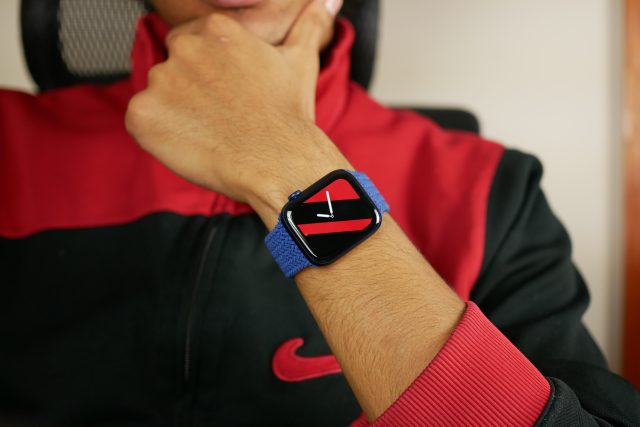
The Apple Watch should be your first consideration when looking for a smartwatch, especially if you’re an iPhone user. If it worked standalone or with Android phones, it’d be hard not to recommend this for just about anyone looking for a smartwatch or fitness tracker. (Maybe those needing highly specialized sport-tracking devices have better options.)
It’s not the most stylish smartwatch (we have a pick for that), but the Apple Watch has become its own measure of style. With the Series 6, Apple added more exciting colors in red and blue beyond the typical silver, space gray, and gold. It still looks like a tiny, rounded little iPhone baby, and that’s largely because it is.But there’s not much this iPhone baby can’t do when compared to your real iPhone. Of course, you’re not going to be surfing the web on it, but when it comes to answering and viewing notifications and being a fitness companion, you don’t need your phone for much. In fact, LTE-enabled Apple Watches (Series 4 and newer) are actually capable of working entirely standalone after the initial setup is done with a parent/family organizer’s iPhone.
Even without LTE, Apple Watch Series 6 comes with GPS, a compass, always-on heart rate monitoring, an ECG sensor, an always-on altimeter, and constant blood oxygen monitoring. The accelerometer has even been updated to detect falls and alert emergency services and contacts. It can truly allow you to leave your phone at home, or at least in your pocket during the day-to-day minutiae of checking notifications, responding to messages, and taking calls.
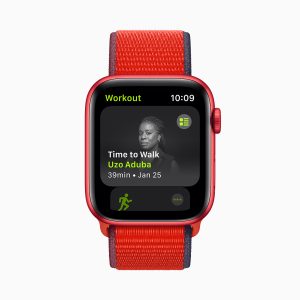
Apple Watch Series 6
Software helps. Specifically, the robust and familiar watchOS 7 operating system, which has so many apps that it needs its own dedicated app store—there’s even an app to use your Apple Watch as your car key for select new BMWs (coming soon for other cars). Deepened third-party app integration is highlighted by bespoke Watch complications that can separate functions of an app into different icons within a single watch face, provided the developer has done so, as many have. Throw in new customizable watch face designs and the ability to share or download watch faces, and this adds up to a deeply customizable visual and interactive experience on your wrist.
There’s a very wide range of activities you can track in the Workout app, from climbing and dancing to boxing and fencing, as well as the requisites like swimming, running, and biking. There’s not a ton to investigate after the fact, though, just your heart rate, calories burned, and time spent. Unfortunately, those details are only viewable in the immediate summary on your wrist, and they can’t be recalled for review after that.
These logged activities are more aimed at closing your Activity rings, the broader emphasis being to do this consistently. The same goes for sleep tracking. While you can see duration and blood oxygen readings, the app pulls focus toward hitting your goal sleep time and your trends toward, or away, from doing so. You can track your VO2 max based on a hike, run, or brisk walk outdoors, and that’s about as deep as health metrics get.
Pairing headphones with the watch, you can stream and store music on your wrist with Spotify or Apple Music. Battery life is about a day to a day and a half, though, and using GPS and streaming music without your phone will keep you closer to a day’s worth of battery, requiring a charge before bed.
If you’re hoping to save a few bucks on an Apple Watch, you can sometimes catch modest sales, particularly around holidays. Or, if you’re not in need of the always-on display, blood oxygen sensor, and ECG sensor, then you can save a few bucks with the Apple Watch SE.
Lastly, there’s the Apple Watch Series 3. It lacks the same sensors just mentioned in the SE’s omissions, and it further loses the always-on altimeter, though intermittent altimeter readings are available. It’s an attractive buy at, and sometimes under, the $200 mark, but just be aware that it’s better viewed as a smartwatch than a health or fitness tracker considering all the features it lacks in comparison to the Series 6 and most of its competitors.
Runner-up
Fitbit Sense
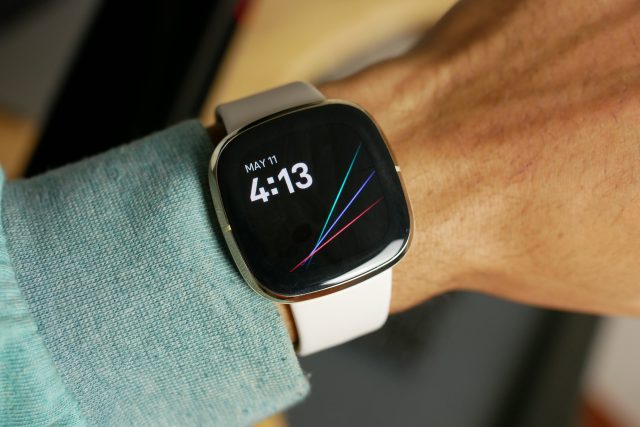
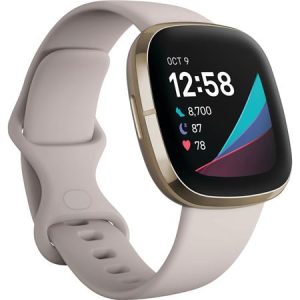
Fitbit Sense
Stylistically, it certainly looks similar to an Apple Watch, with its shiny square case, bright and vibrant display, and silicone band. Upon closer inspection, it’s easy to see the differences, though. The band latches differently and connects to the watch with a proprietary, still seamless mechanism, but the all-around feel is just as comfortable as an Apple Watch. You can also shop around for a variety of leather, silicone, and fabric bands, some made of recycled materials or with reflective fibers for hikers and runners.
The Sense also offers cutting-edge fitness-tracking hardware, like an ECG monitor and blood oxygen readings, although the latter doesn’t offer spot readings unless you pay for Fitbit Premium. Without that, the sensors are used only during sleep. Requisites like GPS, heart rate monitoring, and an altimeter are all on the Sense, as are skin temperature monitors and electrodermal activity sensors for stress measurement.
As far as smartwatches go, the Fitbit Sense covers the requisites well, allowing notifications from most any app for iOS or Android. But being universally compatible means shallower integrations, especially with first-party functions like responding to texts or emails. You won’t be able to reply to text messages or emails from your iPhone, but you can reply to texts with an Android phone using quick replies or voice dictation. Phone calls on the Fitbit are also possible with either iPhones or Android devices.
If that’s about all you need from your phone, then the Fitbit Sense is a strong contender. Just don’t expect a bevy of bespoke app complications or shortcuts to specific functions, as the Sense’s only mainstream third-party apps are a handful of music services, like Spotify (which doesn’t stream from the watch, but rather just controls streaming on another device), Deezer, and Pandora.
Inexplicably, the Sense loses the ability to download your own music files onto your device (which the Versa 2 can) unless you have either a Pandora Premium or Deezer Premium account (neither of which is widely popular). So, if going for hikes or runs without your phone is important to you, this and the lack of cellular connection capabilities may be important to consider.
A slightly more affordable smartwatch we like
Fitbit Versa 3
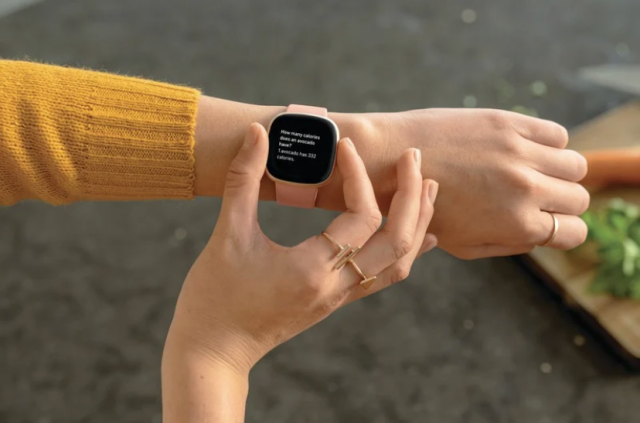
Not everyone is ready to spend $300-$400 on a smartwatch, even if they can be surprisingly useful accessories. Luckily, Fitbit Versa 3, which retails for $230 but can sometimes be found for less than $200, maximizes its value.

Fitbit Versa 3
The Versa 3 is a capable smartwatch that brings all your smartphone’s notifications to your wrist (or just the ones you specify). It houses a voice assistant—you can choose either Alexa or Google Assistant—and enables quick text replies on Android devices with either preloaded responses or dictation from the built-in mic. Both iPhone and Android users can take phone calls on their wrists, as there’s a built-in speaker, as well.
Plus, it is a Fitbit, so you have a waterproof design (rated for up to 50 meters) that tracks swims, runs, cycles, sleep—there are more than 20 activity tracking modes in total. Throw in six-day battery life and access to Fitbit Premium’s deeper, more tailored fitness guidance (typically $10 a month, though a three-month trial is included), and you have a good-looking and capable smartwatch and fitness tracker at a price that’s difficult to beat.
Best runner’s smartwatch
Garmin Forerunner 745
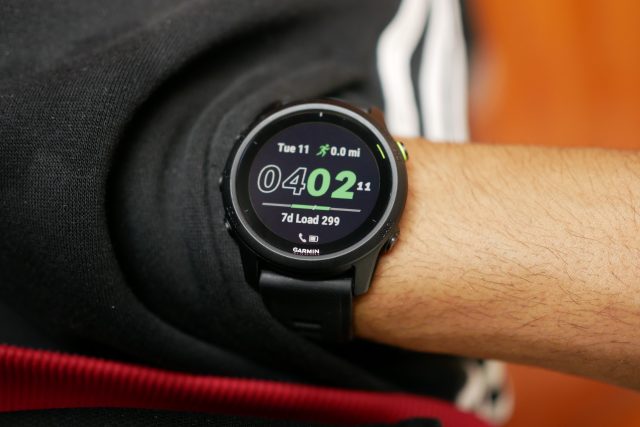
If you’re looking for a smartwatch for runners, then you want the metrics, battery life, and phone independence of a purpose-built device. Answering a text or taking a call while away from your phone doesn’t matter as much as focused stats from a bevy of sensors, training analysis, and guidance that helps you train more efficiently. Garmin’s Forerunner 745 is just that.
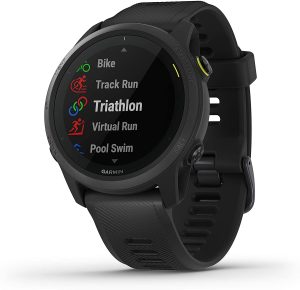
Garmin Forerunner 745
From the watch face, you’re only a couple of button presses away from checking your phone’s notifications, starting a new workout, or recalling a saved route or playlist you’d like to use directly on the watch during your next run. iPhone users won’t be able to interact with notifications in any other way but to read and clear them, though Android users can reply to texts with up to 30 premade responses and decline calls with three responses, all customizable in the Garmin Connect app.
There’s 4GB of storage for up to 500 songs on your wrist, whether from Spotify or your own library, which you can listen to with paired Bluetooth headphones. You can also use that space to download running and cycling routes.
With a GPS, heart rate monitor, altimeter, blood oxygen sensor, compass, and thermometer, the Forerunner 745 has virtually anything you can ask for in a fitness tracker. Throw in NFC payments with Garmin Pay, and you won’t need your phone for anything but taking calls and replying to messages, as Garmin watches don’t have a cellular connection.
The watch offers a variety of health metrics to cycle through, including your body battery, heart rate, blood oxygen levels, VO2 max, and training status. The latter two touch on some of the deeper metrics and analysis a bespoke runner’s watch affords. Your VO2 max, for instance, also predicts your performance in a 5K, 10K, half-marathon, or full marathon, as well as your estimated fitness age.
Training status is one of the many calculations offered from the 745’s specified suite of “training, planning, and analysis” tools. Status, in particular, tells you whether your fitness is improving, plateaued, or degrading based on your recent efforts, or lack thereof. Other metrics within this suite explain the impact of your exercise on your aerobic and anaerobic fitness (think going for a five-mile jog vs. HIIT) and recovery times. But you still have more basic data, like calories burned and a breakdown of time spent in each heart rate zone during your exercise. Most of this is available through the watch, with some finer details only shown in the Garmin Connect companion app.
Pairing a separate Garmin chest strap heart monitor gives more precise cardio information, as well as running form analysis and an estimated lactate threshold. Those latter two details can help you avoid overtraining and injury on your runs.
If sleep tracking is important to you, though, the 745 probably isn’t your best bet with its current software. In our experience, the watch was often off by hours, giving credit for sleep we know didn’t happen. Until a potential update arrives, we can’t say it’s a reliable sleep tracker. That’s a bit of a letdown considering how holistic a view of your health the 745 can afford you otherwise.
For those interested in the watch for more than running, there are about 35 different activity tracking modes, from cross-country skiing and mountain climbing to yoga, elliptical exercise, and strength training. Third-party developers also create free and paid activities that can be added and tracked just as comprehensively, sometimes more, (which I had to do for my boxing). Just know those third party apps are not always free.
In our usage, battery life was about two and a half days with 24-hour blood oxygen monitoring on, and around three to four days without that—all compared to the seven days it’s rated for.
Best smartwatch for more casual runners: Garmin Forerunner 245 Music
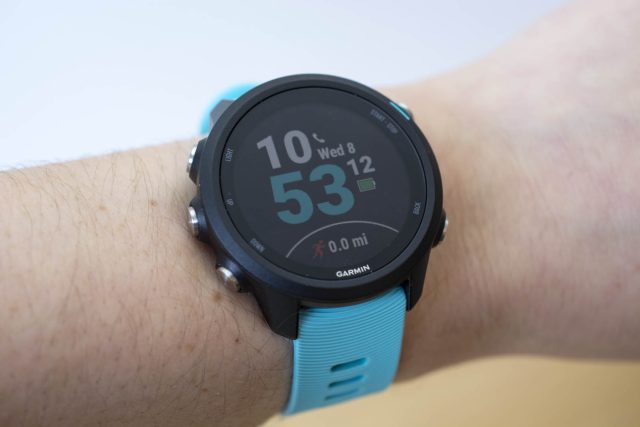
For those who trend less toward triathlete and more toward morning, afternoon, or weekend runner, Garmin's Forerunner 245 Music and Forerunner 45 may be good options to save some money.
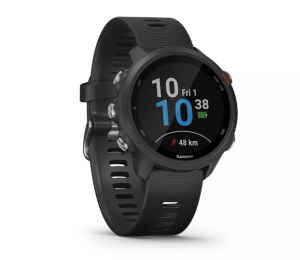
Garmin Forerunner 245 Music
Better yet, the 245 keeps support for two of our favorite Garmin features: Training Effect/Training Load and Running Dynamics. As mentioned, the Training Effect feature explains your training’s impact on your aerobic and anaerobic fitness, while the Training Load helps you stay within the sweet spot for activity levels to maintain progress and avoid overtraining. Running Dynamics requires one of Garmin’s chest-strap heart rate monitors (as it does with all Garmin watches), but this tool offers insight on running form for efficiency and injury prevention.
GPS, blood oxygen monitoring (spot check and during sleep), and heart rate data (during activities and sleep, not 24/7) are all at your disposal on the 245, as well as storage for music, but there is no Garmin Pay support. Runners who appreciate the ability to create round-trip courses in-app and use the watch to navigate them will also miss that feature on the 245 Music.
Best basic running smartwatch: Garmin Forerunner 45
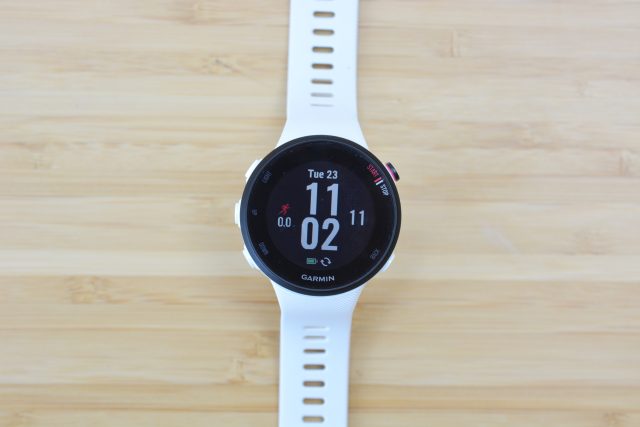
The Forerunner 45 is even more stripped-down but, at a $150 price point, it could be just the ticket for casual runners. GPS and heart rate are still in tow, but the watch lacks blood oxygen monitoring, an altimeter, a compass, support for Garmin’s chest strap heart rate monitors, and Garmin Pay.
There’s also no support for course creation/navigation, incident detection or assistance without a smartphone. The Forerunner 45 also lacks music storage. This is a watch that’s best suited for those who don’t trek far for their runs, don’t need music, and/or otherwise aren’t bothered by carrying their phone with them for music or in case of emergency. Although no Garmin watches can make calls, the 745 and 245 can still alert friends and family in the event of a detected or manually initiated emergency—but that's a feature the Forerunner 45 lacks.

Garmin Forerunner 45
Best Android smartwatch
Samsung Galaxy Watch 3
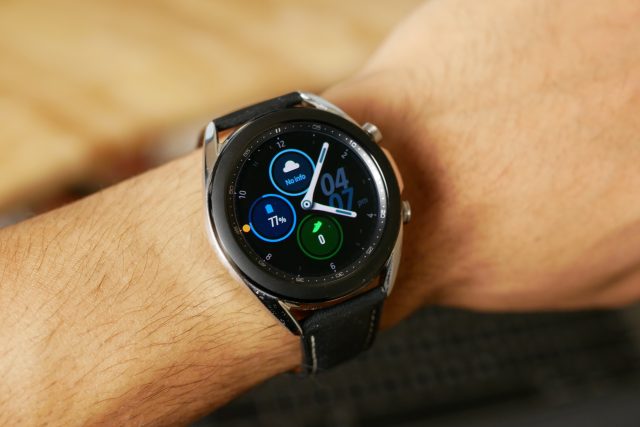
Somewhat unsurprisingly, Android device manufacturers have never really been able to come up with a wearable as seamless and supported as the Apple Watch. It’s not all their fault. Google neglects its Wear OS platform, which was already playing catch up. And that leaves watches powered by this further and further behind. Third-party developers have had little incentive to spend time and resources supporting Wear OS.
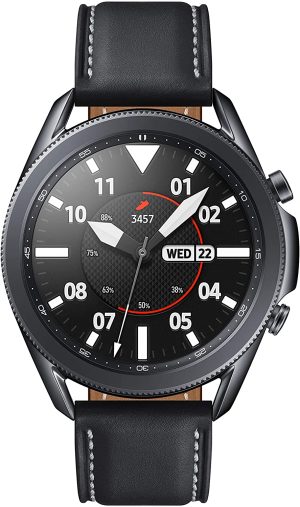
Samsung Galaxy Watch 3
On the Galaxy Watch 3, Tizen’s a sharp, fun OS to use. Its strengths start with OS navigation, which uses a physical rotating watch bezel to scroll through lists, messages, apps, and information cards. Rotating it gives a satisfying tactile sensation, somewhere between a click and a bump, as though little spring-loaded metal ball bearings facilitate the movement and keep it in place.
It’s easy, and actually fun, to scroll around the watch in this way, rotating from card to card like you’re flipping through swatches. Checking the weather, reading notifications, or looking in on your health and fitness stats is seamless.
The rotating metal bezel surrounds a 1.2- or 1.4-inch AMOLED display set within either a stainless steel or titanium case. Coming in silver, black, and a rose gold-esque bronze color, it easily achieves a classic watch design—particularly in the bronze and black models. They come with leather bands that can be swapped out for 20mm or 22mm watch bands for the 41mm and 45mm watch cases, respectively. That means you can easily add a metal link band to lean into the jewelry look or a silicone band to splice the sporty style.
As mentioned, SpO2 and ECG readings are only available when paired with a Galaxy phone, but otherwise, you have heart rate monitoring, music storage, and 5ATM water resistance for your tracking and fitness needs. There’s quite a good number of activities to choose from, as well as sleep tracking with scores, but guided exercises that count reps based on your motion is a standout feature. This works on several exercises, from barbell curls to deadlifts, and it's accurate enough to actually be used. The watch vibrates and beeps at each rep count, keeping track quite faithfully.
As for your day-to-day smartwatch needs, whether paired with a Galaxy, Android, or iPhone, the Galaxy Watch 3 delivers notifications from all your apps and does so pleasantly and effectively. In this regard, it’s among our favorite wearable experiences, but do note that iPhone users might experience issues with connection stability to the phone. For this and a laundry list of other reasons, an Apple Watch is still the best bet for iPhone users. And if deeper health metrics and support are your bag, then a Fitbit Sense may be a better option. In practice, the Galaxy Watch 3 is a well-made balance between those two.
Most stylish smartwatches
Remember when watches were meant to be jewelry? Especially now that we have phones to tell us the time, a timepiece needs to look good to make you want to wear it. But why have something on your wrist that can’t also show you smartphone notifications? That’s where these Garmin watches come in, blending the best of both worlds.
Gender may be a societal construct more than anything else, but that doesn’t stop companies from making bespoke styles for men and women. Nor does it stop you from choosing styles you like. Women’s smartwatches tend to be on the smaller side; men's watches are often plainer in style. But whatever your preference, here are two beautiful examples.
Most stylish men's or unisex smartwatch: Garmin Vivomove series
-
Garmin's Vivomove Luxe has premium materials like 24K gold and a hidden touch screen, achieving a high-tech, high fashion aesthetic. It's indistinguishable from a traditional watch with the screen off.Corey Gaskin / Ars Technica
-
Garmin's Vivomove Luxe with the screen off.Corey Gaskin / Ars Technica
To our eyes, Garmin’s Vivomove watches are sleek, chic, and classy. Their innovative designs combine mechanical watch hands with hidden AMOLED/OLED touchscreen displays underneath, masked by gold or silver watch faces. When the watches are awakened, either a full-color (Vivomove Luxe or Vivomove Style) or white-light (Vivomove 3/3S) display illuminates graphics behind the watch hands, which appear to be projecting their shapes right through the metal-colored watch face. The watch hands also align to be perfectly horizontal when interacting with the touchscreen. It’s a head-turning and downright cool design, both aesthetically and technologically.
Swiping the watch’s lens for the first time feels like you’re swiping on a regular mechanical watch, and you half-expect the touchscreen you know is underneath not to respond. There is, after all, an air gap between the lens and display that allows the watch hands to move through their range of motion. Because of this, it’s not the most tack-sharp touchscreen experience when it comes to responsiveness, and the Vivomove sometimes requires slightly more deliberate swipes rather than light flicks. Thankfully, this does very little to detract from the user experience.
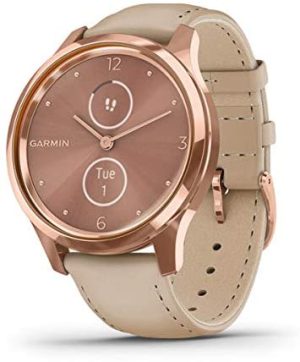
Garmin Vivomove Series
Navigation is simple. Raise your wrist or tap the watch to illuminate the hidden display and view your customizable watch face or swipe through horizontally to check notifications, weather, and health stats. Heart rate and blood oxygen are tracked throughout the day, as are your activities (and sleep) and spot checks. GPS, a barometric altimeter, and 5ATM water resistance ensure that you’re getting all the data you need from your runs, swims, or cycling sessions. Unfortunately, there’s no way to store music on the watch, though.
All these activities have their own modes, but you also have options for strength training, cardio, elliptical exercise, stair-stepping, and yoga, specifically. The yoga activity can even track respiration rate (the watches also track respiration 24/7, outside of activities), though the rep counting feature didn’t prove useful during strength training. Garmin Connect, the watch’s companion app, still offers you some of the company’s signature quantified metrics like fitness age, body battery, stress, and sleep tracking. Battery life is up to five days in smartwatch mode, but the watch hands will still tell time for up to an additional seven days.
Garmin’s watches are compatible with both iPhone and Android devices, and although notifications for any app will come in, you won’t be able to respond to them from the watch. If that’s of little concern to you but classic styling and solid fitness tracking are important, a Vivomove watch might be just what you’re looking for.
The Vivomove Luxe has an MSRP of $450 and features stainless steel, 24K gold, and 18K rose gold as case options. All of those have stainless steel, color-matched bezels, and Sapphire Crystal lenses covering their full-color AMOLED touchscreens, with Italian leather or Milanese stainless steel mesh bands attached.
The $250 Vivomove Style keeps the color AMOLED display but swaps Gorilla Glass 3 in for the lens. All metal components (case, bezel) are anodized aluminum, and the watch comes with silicone or woven nylon bands.
The $200 Vivomove 3 and 3S (the latter is just smaller) have polymer cases with stainless steel bezels, chemically strengthened glass lenses, and silicon bands. They lack contactless payments, unlike the Vivomove Luxe and Style, but still carry a polished and traditional look. As mentioned, the touchscreen display uses only white light to illuminate and outline figures in the watch's face.
Most stylish women's or smaller-wrist smartwatch: Garmin Lily
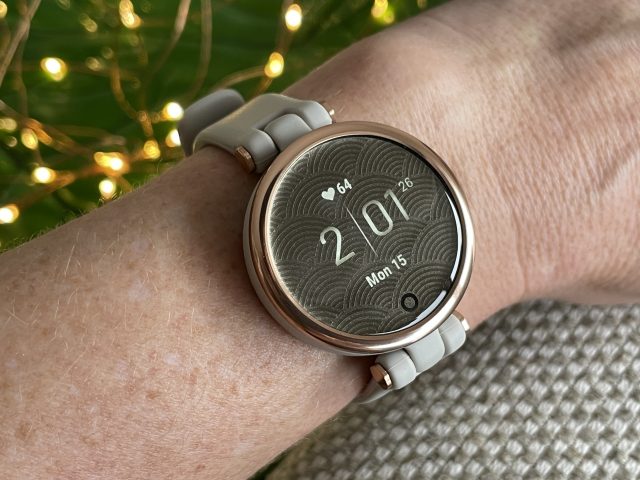
Garmin’s Lily smartwatch is another great-looking option for women or those with smaller wrists. Its one-inch face resembles the Vivomove’s, with metallic-colored dials and metal bezels (stainless steel on the Classic Edition and aluminum on the Sport), but it lacks the physical watch hands that Vivomoves have. The case isn’t metal all the way around like on the Vivomoves, so aside from the bezel, you’ll have a colored, “fiber-reinforced” polymer case.
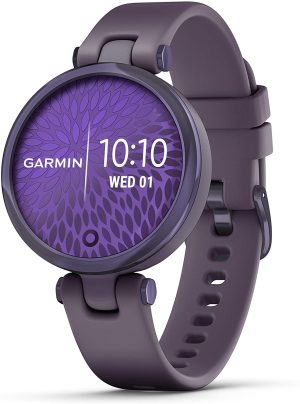
Garmin Lily
Functionally, it’s a simple device to navigate. Swiping horizontally from the main screen, you can see your notifications, the weather, and various health stats, like your current heart rate, body battery, blood oxygen saturation, and stress levels. Tapping into each gives you a broader context on how these have changed over time. Or, you can also view this and much more, including sleep and menstrual cycle tracking, in Garmin’s Connect companion app.
You can initiate activity tracking sessions on the watch, including those for running, biking, swimming, strength training, cardio, elliptical training, stair-stepping, yoga, Pilates, and breathwork. All of those modes record heart rate and blood oxygen saturation, as well as calories burned and steps taken. Neither music storage nor GPS are built-in though, so you’ll need to have your phone with you if you’d like tunes or route tracking on your runs, cycles, or swims.
One of the biggest selling points for the Lily, like any Garmin watch, is the deeper, more specific health and fitness data found both in-app and on your wrist. The Connect app organizes each activity session with easy-to-read charts, mapping your heart rate throughout and giving estimates for calories burned and sweat lost. For sleep, you’ll get duration and approximated sleep stages, along with charts displaying your movement, blood oxygen saturation, and respiration patterns through the night.
Between the Lily Classic and Sport Editions, there are six colorways in total (three of each), all with different dial colors and designs. The Classics all have leather watch straps, while the Sport editions use silicon, but they both attach to the case with a metal bolt that helps set its aesthetic as a jewelry piece rather than a smartwatch. But looks can be deceiving: these are still smartwatches, of course. Having notifications you can read (but not reply to) on iPhone and Android devices paired with Garmin’s strong fitness tracking prowess and elegant looks make for a stylish triple-threat.
The Link LonkMay 12, 2021 at 10:15PM
https://ift.tt/3tB24Ak
The best smartwatches for every type of user - Ars Technica
https://ift.tt/2YGK9Ms
Smartwatch
:no_upscale()/cdn.vox-cdn.com/uploads/chorus_asset/file/22689672/lil_baby_drake_rolex.jpg)
No comments:
Post a Comment